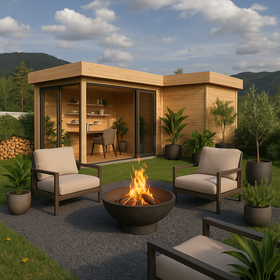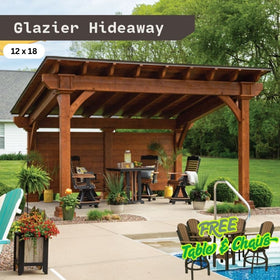512-777-0154

What Are Micro Homes? The Definitive Guide to Size, Legality, and the Tiny Living Movement
What are micro homes? They’re small, smart, and surprisingly livable spaces that prove comfort doesn’t depend on square footage. These homes have taken the housing world by storm, giving people a way to live more with less.
Instead of chasing bigger homes, more homeowners are chasing freedom. Micro homes offer a lifestyle centered on intention, not clutter.
Whether you’re curious about legality, cost, or how tiny is too tiny, this guide walks you through it all.
What is Considered a Micro Home vs. a Tiny House?
Not all small homes are created equal. Micro homes and tiny houses often get lumped together, but they’re not quite the same thing. The difference lies in their size, structure, and how they’re built or used.
Let’s break it down so you can see where your dream small home fits in.
The Legal and Industry Standard for “Tiny House”
The official rulebook for tiny houses comes from the International Residential Code (IRC), Appendix Q. It defines a tiny house as 400 square feet (37 square meters) or less in floor area, not counting lofts.
This gives builders a framework for safety, insulation, and layout. It’s also what helps local governments recognize tiny homes as legitimate housing options.
So if your home’s footprint fits within 400 square feet, you’re officially living in a certified tiny house. That’s the gold standard of tiny living.
Defining a “Micro Home” and Other Small Dwellings
The term “micro home” is a bit more flexible. These are often compact dwellings under 350 square feet (about 15–25 square meters). You’ll find them tucked into cities, built as freestanding backyard units, or even stacked into micro-apartment buildings.
Micro homes focus on efficiency and sustainability. They often feature built-in furniture, fold-out beds, and clever storage tucked into every nook. While a tiny house might sit on wheels or a foundation, a micro home usually stays put, especially in urban settings.
Here’s a quick look at how these sizes compare:
| Category | Square Feet | Square Meters |
|---|---|---|
| Micro Home | 100–350 | 9–32 |
| Tiny House (IRC-defined) | Up to 400 | Up to 37 |
| Small Home / Cottage | 400–700 | 37–65 |
These aren’t hard rules, but they help you understand where your space fits on the small-home spectrum.
Where Does 700 Sq. Ft. Fit In?
So, is 700 square feet still considered a tiny house? Not officially. By code, it’s too big to qualify. But in the world of small living, it still counts.
Homes around 700 square feet fall into the “small home” or “cottage” category. They’re ideal for people who love the idea of downsizing but still want room for a full kitchen, a sofa, and maybe even a second chair.
Think of it as a comfortable step toward minimalism: small enough to simplify your life, but not so tiny that you’re bumping elbows every time you turn around.
Who Can Live in a Tiny House? (And the Regulatory Roadblocks)
Tiny homes may look simple, but the rules around living in them aren’t always as clear. Local laws and zoning codes determine who can live in one, and where. That’s where things get tricky.
Let’s look at the main legal factors that shape tiny living.
1. Understanding Zoning Laws and Permanent Foundations
Zoning laws decide what kind of structures can sit on a piece of land. Some towns still require homes to meet a minimum square footage, often larger than a tiny or micro home.
That means you might not be able to build a small home on a foundation without getting special permits. However, several states like Oregon and California are opening doors for tiny living by allowing Accessory Dwelling Units (ADUs) or secondary small homes on residential lots.
These changes are helping more people join the movement without breaking local building laws.
2. The Difference Between a THOW and a Permanent Dwelling
A Tiny House on Wheels (THOW) is a bit like a camper that looks like a home. It’s often built to RVIA standards and is legally treated as a Recreational Vehicle (RV). That classification affects how and where you can live in it full-time.
In most places, THOWs can only stay long-term in RV parks, tiny home communities, or private properties with specific allowances.
On the other hand, a tiny house like GardenHouse24 USA Arhus 70, built on a permanent foundation must meet residential building codes. It can’t roll away, but it’s more stable legally and financially.
3. Overcoming Restrictive HOA and Community Regulations
Even if your city says yes, your Homeowners Association (HOA) might say no. Some neighborhoods have strict appearance rules or size limits that make small homes difficult to approve.
People often sidestep these challenges by moving into tiny home-friendly communities or rural areas. These spots not only welcome small houses but also foster community and shared resources like gardens and solar power.
For anyone dreaming of small living, these communities are a growing and practical solution.
The Tiny and Micro Home Market: Trends and Buying Options
The small home market has grown from a niche trend into a thriving industry. Whether you’re after a modern prefab, a cozy cabin, or a recycled shipping container, there’s something for every taste and budget.
Let’s explore how people are getting their hands on one.
New Builds vs. Pre-Owned and DIY Options
There are three main ways to join the movement.
- Custom or modular builds: Professionally designed and built for your lifestyle.
- Pre-owned homes: Available through online listings or tiny house marketplaces.
- DIY or kit homes: Affordable and satisfying if you’re handy, including prefab container or cabin-style kits.
Each path offers a different mix of control, cost, and effort. The key is finding what suits your time, skills, and wallet.
Current Market Costs and Financing Challenges
Tiny and micro homes come with smaller price tags, but financing them can be complicated. A professionally built model usually ranges from $30,000 to $150,000. Prefab or container-style micro homes can start closer to $20,000.
Because these homes don’t always qualify for standard mortgages, buyers often turn to personal loans, RV loans, or builder financing. It’s one reason why tiny home communities have become so valuable: they simplify land and setup logistics.
The Rise of Tiny House Communities and Micro-Villages
Tiny house communities are changing how people live small. These organized neighborhoods bring together clusters of micro homes with shared resources like gardens, laundry areas, and utilities.
They’ve become a practical and social way to live tiny legally. Many communities lease land or provide pre-zoned lots, making it easier to get started without the headaches of local red tape.
It’s housing made simple, connected, and community-driven.
The Lifestyle Shift: Why Choose a Smaller Home?
Going small isn’t just about saving space. It’s about saving time, money, and mental bandwidth. Living tiny often brings people closer to what matters most: family, freedom, and experiences over things.
Let’s look at why this shift feels so powerful for so many.
Financial Freedom and Reduced Debt

A smaller home usually means fewer bills and less maintenance. Heating and cooling cost less. Cleaning takes minutes, not hours. And with fewer expenses, people often find themselves debt-free faster.
That financial breathing room lets many pursue hobbies, travel, or simply work less. It’s a lifestyle that trades stress for freedom.
Embracing Minimalism and Intentional Living
Micro living teaches you to live with intention. Every item earns its place. You start choosing things that add real value instead of clutter.
Many who make the shift say they feel lighter, not just physically but mentally. Life becomes less about managing things and more about enjoying the space you have.
Navigating the Small Home Spectrum
From urban micro apartments to cozy cottages in the woods, small homes come in all shapes and sizes. What connects them is a shared desire for simplicity and purpose.
Before diving in, learn your local regulations, explore financing, and think about what small living really means for you. With the right plan, living small can open up a life that feels bigger in all the right ways.






